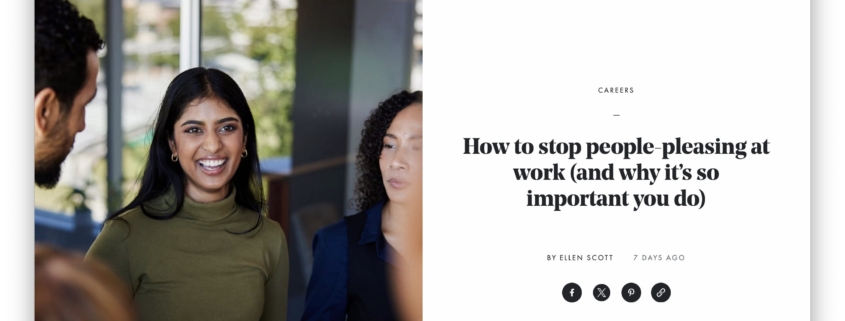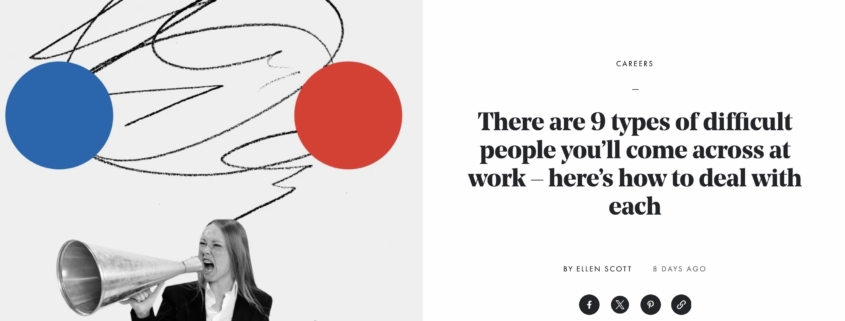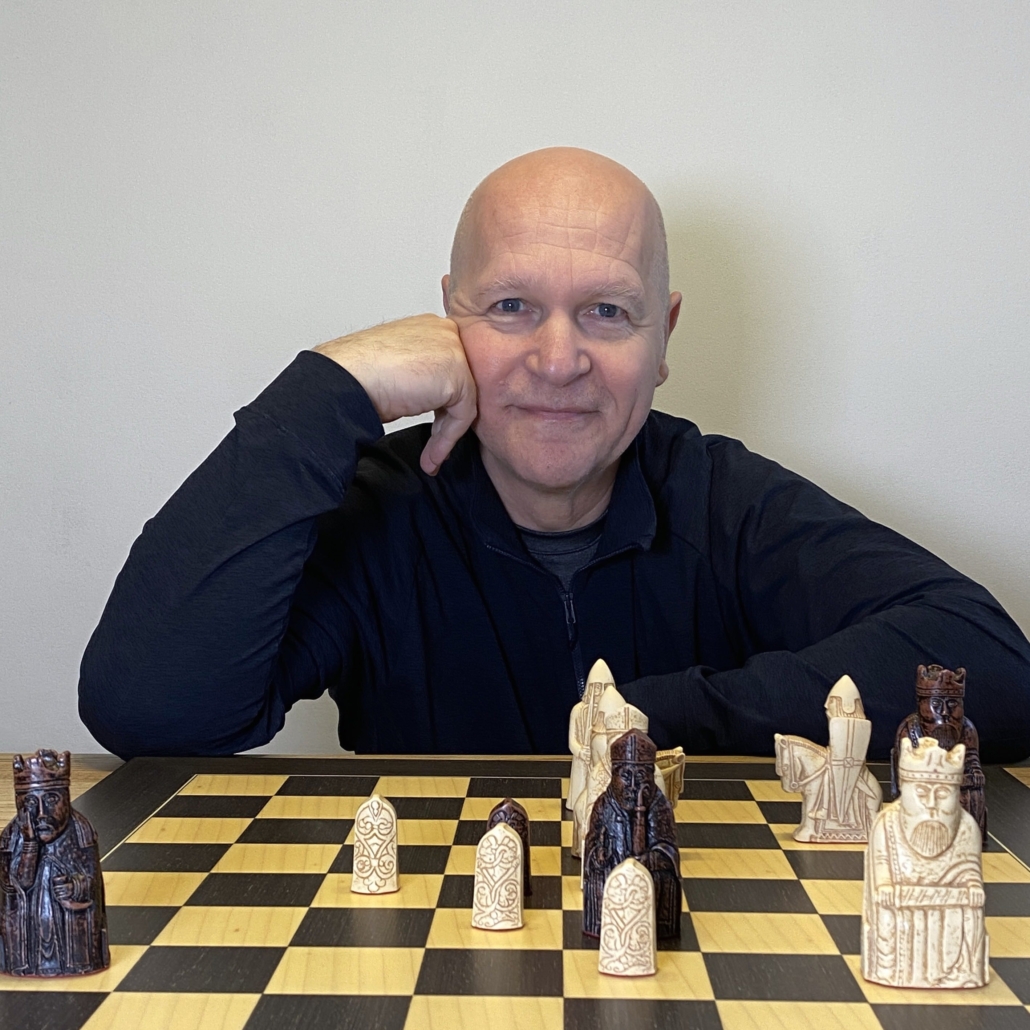Posts
Business Book of the Month Webinar
I was recently interviewed by my publishers Pearson for their Business Book of the Month webinar on LinkedIn.
We talked about my book, The 9 Types of Difficult People at work and had a great Q& A session. I presented some of the most important themes from the book, including:
- How to get your headspace right place for dealing with a difficult person at work
- What it costs the business if you do nothing
- Why people become difficult at work
- Tools and strategies for dealing with them with constructively, effectively, and compassionately.
Click the play button to watch the video of our webinar.
How to Stop Being a People-Pleaser at Work – My Book in Stylist Magazine
More great coverage of The 9 Types of Difficult People in the press, including this super article in Stylist Magazine on How to Stop Being a People-Pleaser at Work
Here’s some of the highlights from the article, which I’ve linked in full below.
🔍 Acknowledging the Issue
Realising that being a people-pleaser can hinder your professional growth in quite a few different negative ways.
📝 Preparing for Difficult Conversations
Techniques for handling those necessary but challenging conversations effectively.
🚫 The Art of Saying ‘No’
Strategies to assert your needs and priorities without adding to the conflict, so enabling healthier workplace dynamics.
💪 Reclaiming Your Power
Emphasising the importance of authentic communication and setting boundaries for personal and professional development.
Click here for the full article in Stylist Magazine.
Why People Become Difficult at Work
Ever experienced someone being really difficult to get on with at work, and wondered WHY?
There are four key reasons:
- Unconscious Reactions to Stress
They’re reacting to what’s going in inside the organisation and its operating environment (and it’s likely there are things beyond their control that the organisation itself needs to fix) - Positive Intentions
They’re trying to achieve something but are having the wrong impact - Self-Doubts and Self-Sabotage
Their own thought-processes are piling on more pressure and more rigidity in how they behave - Inflexible Approaches
They’re not switching the focus of their intentions to suit the people and circumstances around them.
When things aren’t going smoothly, if we can understand what’s behind the way someone behaves at work, it makes it much easier to help them and others to get along well together.
There’s still a lot to do, and it’s important not to jump to blaming or shaming. But understanding Why can be a crucial first step.
To discover more practical tips and strategies for dealing with a difficult person and quickly improving workplace relationships, please check-out my book The 9 Types of Difficult People or explore more of the articles and resources on this website.
My Book in Stylist Magazine: 9 types of difficult people you’ll come across at work
Very pleased to see that we’re getting some great coverage of The 9 Types of Difficult People!
The latest to appear is an article in Stylist Magazine, which bills itself as:
“… the UK’s leading media brand for professional women; talking to 5 million UK women a month and making up 40% of the women’s lifestyle sector.”
I like this article because it gives a good overview of each of the 9 types of difficult people at work. And it features really practical hints and tips to turn things around and create great working relationships for everybody.
Here’s the link to the full article in the magazine:
➽ There are 9 types of difficult people you’ll come across at work – here’s how to deal with each
The Most Committed Managers Are the Most Difficult: The Challenge of the Workplace Martyr
If you’ve ever walked the tricky tightrope of high standards and uncompromising values set by a leader who sees any deviation as a lack of dedication, then you’ve met The Martyr!
To find out how to deal with a difficult Martyr in your workplace, please read on, and check out my book, ‘The 9 Types of Difficult People’.
The Martyr is a highly-principled person with a strong work ethic who builds fiercely loyal teams. They can become judgemental, uncompromising and disconnected from people they regard as less principled or less self-sacrificing.
Whilst their dedication is inspiring, their inability to compromise can stall progress, create friction within teams, and stifle innovation.
Their judgmental outlook and disconnection from ‘less principled/dedicated’ colleagues can lead to a divisive atmosphere, undermining team cohesion and productivity. And if you work for a Martyr, there’s a strong risk that you’ll get dragged down with them, sacrificing your own career or work-life balance without needing too.
If you’ve got a Martyr in your organisation, here’s how to deal with them
If you’re their leader, make sure you’re sharing your own principles. Even if those are different from the Martyr’s, it’s a good way to re-connect with them. Then you can ensure that they know the bigger picture priorities, and why compromise is needed to make some progress towards important goals. And check that you haven’t set them up to fail, with impossible tasks, constraints they can’t control, or a highly risk-averse culture.
If you work for or alongside a Martyr, don’t tolerate their criticisms or judgements of you. And don’t let them turn their back on you. Instead, knock on their door and ask for the kind of mutual compromise that makes sustainable progress possible. Make sure you’re not relying on them to help you develop your career – they’re too ready to unconsciously sacrifice. On the whole Martyrs are sensitive to other people’s needs so will often be very open to any kind of approach.
If you want to help develop a Martyr, your focus should be on exploring what’s behind the negative judgements they make about others and the unhelpful beliefs that might be leading them to self-sacrifice.
Beyond Judgement: The Martyr’s Path to Influential Leadership
At their best, a Martyr can be a transformative leader, able to influence not judge, and so can sweep away roadblocks and be supported by passionate followers, all sustained by a healthy work-life balance.
Have you encountered a difficult Martyr in your workplace?
How did you deal the challenges they presented?
Checkmate – why your brightest colleagues try to keep you in the dark
In the chess game of work there’s a player who is often several moves ahead.
It’s the Dark Strategist 🤯
Featured in my book, The 9 Types of Difficult People, the Dark Strategist is someone who will treat others like chess pieces, to be moved around to deliver an ambitious grand plan.
It’s often just too slow, too tedious and too outside their comfort zone to explain, coach and collaborate with you instead.
But even though they’re smarter than average their approach can be flawed, with important details overlooked. And they can sometimes let a perfect concept be the enemy of a good execution.
However positive their intention, whether it’s steering the company through a crisis or grabbing an opportunity no-one else has spotted, they can leave people feeling manipulated and undervalued. So that, in the end, nothing actually gets properly done.♟️
💡 Here are some of the main tips from my book about how to throw some light on your dealings with a Dark Strategist and quickly improve working relations, whether you’re their leader, a colleague, or a team member. Or just someone who wants to help them stop being quite so difficult!
🌏 As their leader, if you can speak their language – big-picture, strategic-thinking – that’s sometimes enough to coax them out of the dark and towards a rounder approach. Treating people as people and managing concrete tasks as well as abstract strategy.
🤝 As a colleague or a team member of a Dark Strategist, you’ll also need to learn how to co-strategise, connecting your own knowledge and goals to the wider vision. This will keep them connected long enough for you to join in the big chess game too.
♟️ If you don’t do this, you’re likely to get treated as a chess piece yourself. Call this out, and don’t tolerate they’re treating you like an idiot, just because you don’t also start from a big-picture assessment of things. Collaboration is the key to a successful workplace, and doing that well depends on a good variety of skills and approaches.
In the next of these articles I’ll be taking a look at a different type of difficult person at work. Someone whose positive qualities and strong principles can themselves be the cause of problems.
And to see all of the types I’ve covered so far, or to grab a copy of my book, check out the tags below and/or the links to in the sidebar.
Worst Enemy at Work – or Best Ally? How to thrive alongside a Scary Specialist 🤨
Ever found yourself working with or for a Scary Specialist?
You know the type – brilliant, indispensable, but SO challenging to deal with! They’re the ones who know everything about a particular topic, and they’re not afraid to let you know it.
So, how do you turn this potential ‘worst enemy’ into your ‘best ally’?
Here’s the four steps you need to follow:
1️⃣ Raise Your Own Game
- Step up your skills and knowledge. The Scary Specialist respects competence. Demonstrate your own commitment to excellence, and they’re more likely to see and respect you as a peer.
2️⃣ Speak Up, Don’t Suffer in Silence
- If there’s an issue, voice it. Scary Specialists can be intense, but they also respect honesty and directness. Approach them with clear, constructive requests for what you want.
3️⃣ Boundaries Are Your Best Friend
- It’s crucial to establish what you will and won’t tolerate. Be clear about your limits and communicate them confidently. Scary Specialists appreciate those who stand their ground.
4️⃣ Stay Connected
- Keep building relationships within your team and the broader organisation. It not only prevents isolation but also offers you a wider perspective and support network.
Remember, a Scary Specialist doesn’t have to be your nightmare at work.
With the right approach, they can become an invaluable ally, helping you to new heights in your career.
📘If you want to go deeper into navigating workplace dynamics with various challenging personalities, please check out my new book, ‘The 9 Types of Difficult People’, recently published by Pearson and now in the WHS top 10 business books list. Look for the links below or in the sidebar.
And in my next article I’ll be looking at the type of difficult person closest to my own approach – the Dark Strategist 🤯
Mastering the Challenge of the Scary Specialist
The scariest person I ever worked for was a former UK table-tennis champion, then my regional GM.
She had a habit of giving you the hair-drier treatment at the same time as eating a crusty cheese roll. And I was struggling with a new appointment to an under-performing division.
We both knew what needed to be done. But the problem for me was how far and how fast that could happen. Not far or fast enough I realised, in between dodging the crumbs!
Nowadays I really like working with scary specialists like her.
🚀 Why NOT focus on being competent and driven and delivering the best that you can.
🛑 But what I also know now that I didn’t know back then, is that the hair-dryer approach isn’t always the best way of GETTING to that high-delivery place.
And there can also be a lot of collateral damage around a scary specialist. Good people won’t tolerate feeling threatened, belittled or locked-out for long – and will leave. Leading to a spiral of declining performance.
❓Who is or was the scariest person that you ever worked with?
❓And what should you do if you’ve got a scary specialist in your organisation?
Collateral damage is happening and performance isn’t improving. You might be tiptoeing around their threats while being told, “Go away; I’ll sort it!”
Focus on these three points:
- Sometimes, leaders of a scary specialist might find that their skills and competences are so essential that you need to ensure they only ever have the best people and the slickest of support functions around them.
- But more often, leaders will need to also become a little scarier themselves in this situation. To demand that this person develop new ways of managing – or else.
- Use their desire for competence to help. Demand that they develop skills which can also take their people from zero to 100. Not just manage well with an already high-functioning team.
If you’re working alongside or below a scary specialist, it can be an interesting experience! In my next article, I’ll look at issues around defending boundaries, raising your own game, and not becoming isolated in the process.
📚 For more insights into dealing with a scary specialist, please check out my book, The 9 Types of Difficult People. See the links below or in the sidebar.
And in the meantime – keep dodging those crumbs!
Coaching to help leaders and teams turn challenging dynamics into great working relationships







